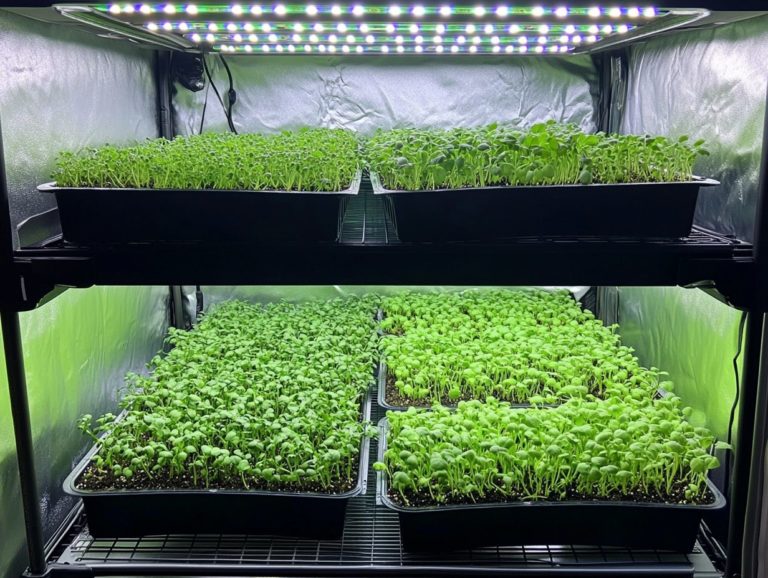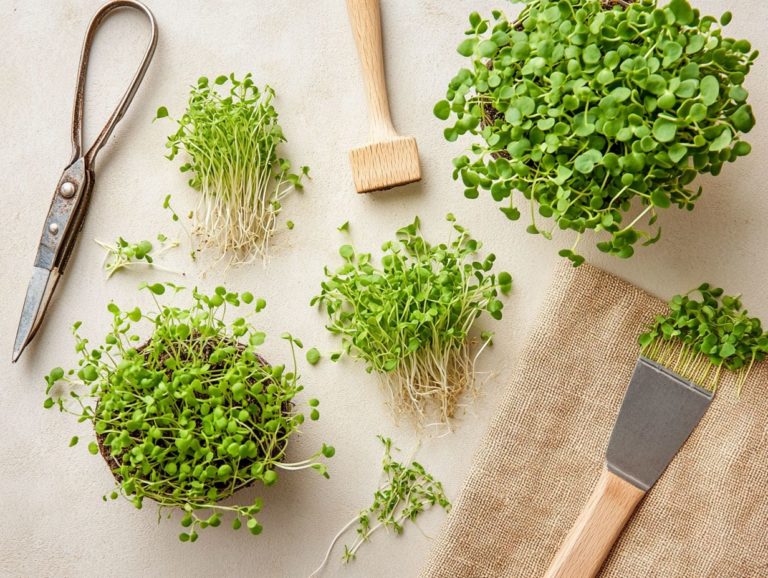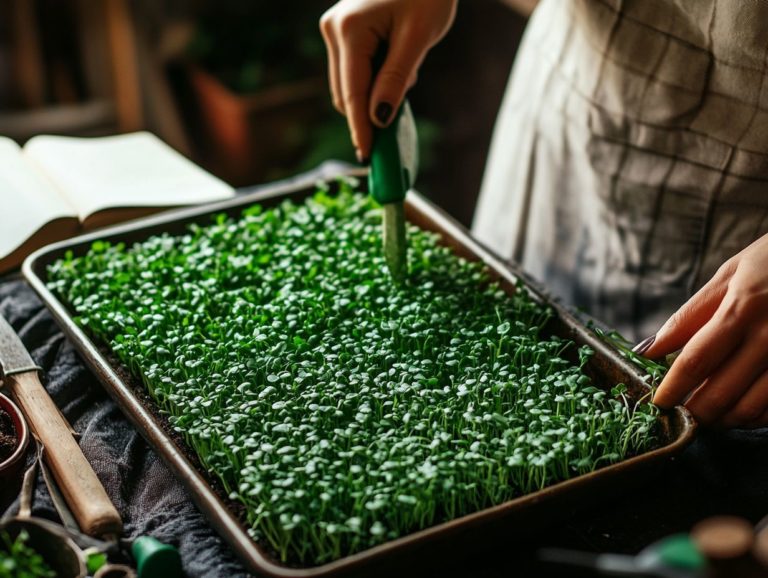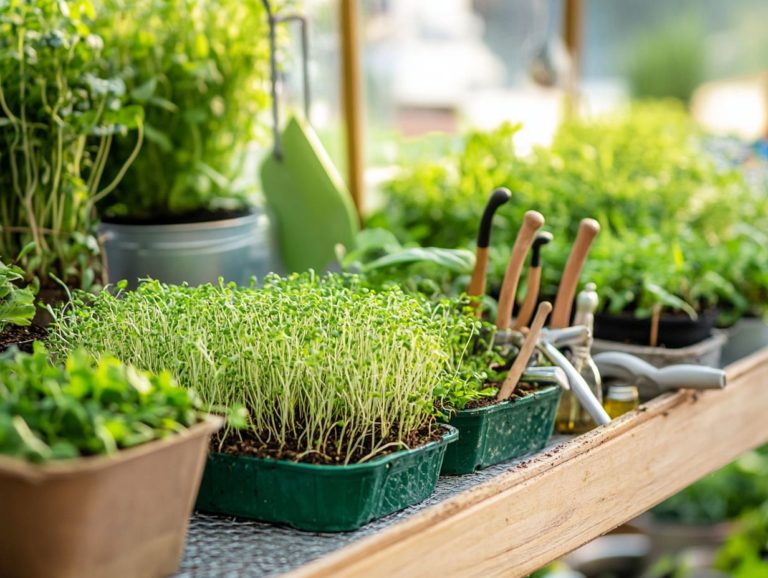Troubleshooting Common Microgreen Growth Issues
Microgreens have surged in popularity, celebrated for their vibrant flavors and impressive nutritional benefits. However, cultivating them presents challenges.
Whether you re a seasoned gardener or just starting your journey, understanding common growth issues is crucial for achieving a successful harvest. This article delves into typical hurdles such as:
- Lighting inconsistencies
- Watering errors
- Pest infestations, including aphids
- Nutrient deficiencies
You ll also find practical tips for harvesting and storing your microgreens. This allows you to savor their fresh taste and fully reap their health benefits.
Contents
- Key Takeaways:
- What are Microgreens?
- Common Growth Issues
- Lighting Problems
- Watering Issues
- Pest Infestations
- Nutrient Deficiencies
- Harvesting and Storage Tips
- Frequently Asked Questions
- What are common microgreen growth issues and how can I troubleshoot them?
- Why are my microgreens growing slowly and not reaching their full size?
- My microgreens are turning yellow. What could be the cause?
- I noticed mold growing on my microgreens. What should I do?
- How can I prevent pests from damaging my microgreens?
- What are some best practices to ensure successful microgreen growth?
Key Takeaways:
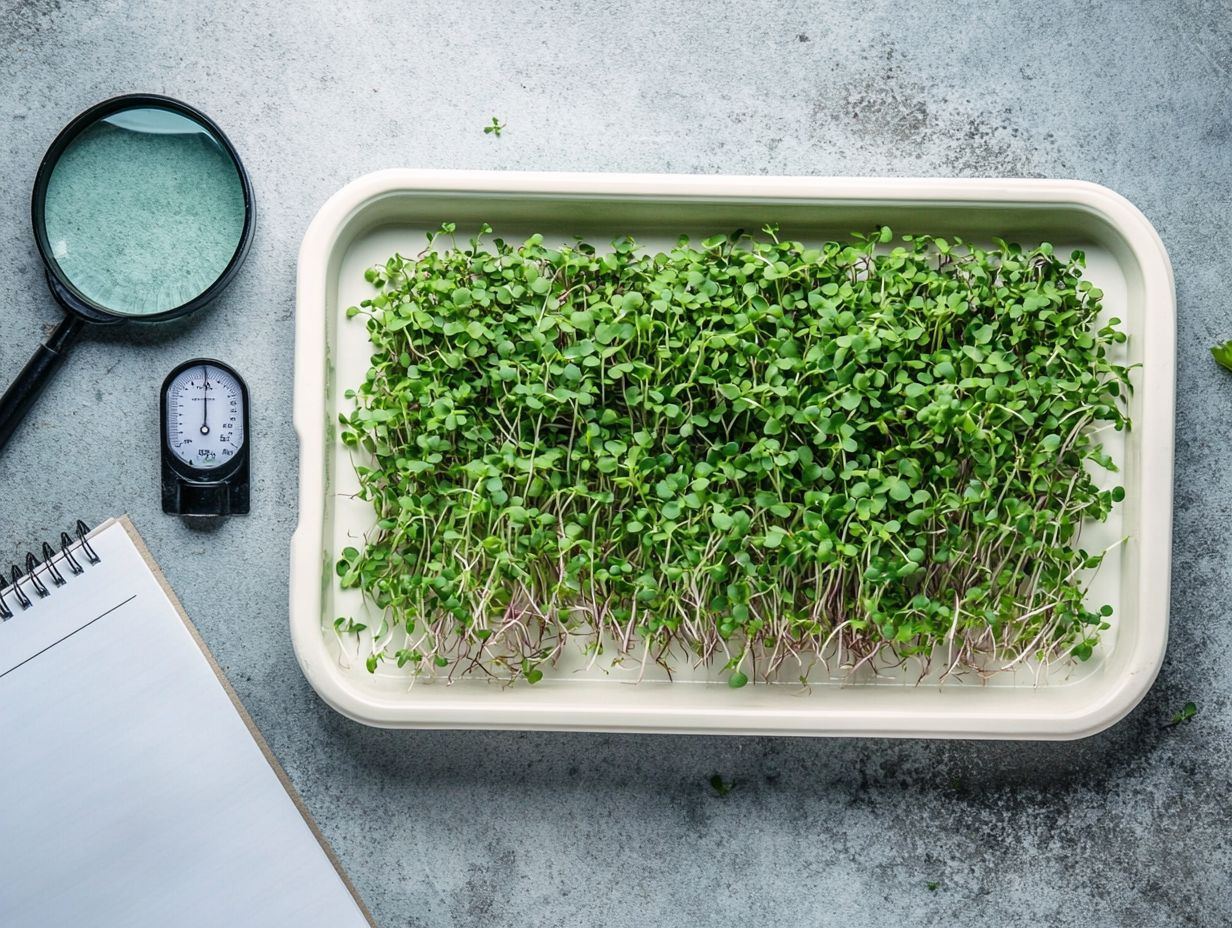
- Proper lighting is crucial for the growth of microgreens. Insufficient or excessive light can lead to stunted growth or leggy stems. Regularly monitor and adjust lighting.
- Watering microgreens can be tricky. Over or under watering can cause issues like mold or wilting. Keep the soil consistently moist, but not waterlogged, and avoid watering from above.
- Pests can quickly ruin a crop of microgreens. Regularly inspect and clean growing trays, use natural pest deterrents, and quarantine any affected plants to prevent larger infestations.
What are Microgreens?
Microgreens are young, edible plants harvested shortly after their first true leaves emerge, typically within 7 to 21 days of germination. These nutritious greens, including varieties like Chia, have gained popularity for their vibrant flavors and exceptional nutritional profiles.
They appeal to both health-conscious consumers and gourmet chefs alike. By cultivating microgreens from reputable sources such as Botanical Interests and MP SEEDS, you can embrace a sustainable way to enrich your diet with fresh produce brimming with vitamins, minerals, and antioxidants.
Common Growth Issues
Growing microgreens is an exciting and rewarding journey. It s essential to recognize that challenges often accompany this process. You may encounter common growth issues such as mold and damping-off disease, a fungal condition affecting seedlings caused by pathogens like Pythium, Rhizoctonia, and Fusarium. Various pests can also impede the healthy development of your seedlings.
Employ proper seed treatment and preventive measures, such as maintaining optimal temperature and ensuring good air circulation. This can significantly enhance your success rate in cultivating vibrant and flourishing microgreens, especially when you have a solid grasp of Understanding Microgreen Growth Cycles.
Identifying and Addressing Common Problems
Identifying and addressing common issues in microgreen cultivation is essential for ensuring a bountiful harvest. If you notice slow or leggy growth, it often points to insufficient light or overcrowding. Visible pests can wreak havoc on your crops if you don t act swiftly.
By closely monitoring your growing conditions and ensuring proper drainage, you can foster an environment that promotes healthy growth. Watch for seedlings that stretch excessively toward light sources this signals inadequate light levels.
If you observe a dense cluster of sprouts vying for space, it s a clear indication of overcrowding. In such cases, thinning out seedlings may be necessary, allowing each plant the room it needs to thrive.
Proper lighting is vital. Consider placing your microgreens under grow lights for 12 to 16 hours a day to ensure they receive the appropriate lumens. For pest management, adopt organic techniques like introducing beneficial insects, applying neem oil, or using insecticidal soap to keep pest populations in check. Additionally, understanding microgreen growth rates can further optimize your growing process.
Regularly inspecting your microgreens and adjusting their spacing can lead to healthier, more robust plants. With a little attention and care, you ll set the stage for a thriving microgreen garden.
Lighting Problems
Proper lighting is crucial for achieving the best growth for microgreens. Both insufficient and excessive light can lead to less-than-ideal results.
When light is lacking, you might see weak, leggy plants struggling to reach their potential. Conversely, an overabundance of light can induce stress and stifle healthy growth.
By mastering the balance between light intensity and temperature control, you can cultivate robust microgreens that flourish beautifully, whether indoors or outdoors.
Insufficient or Excessive Light
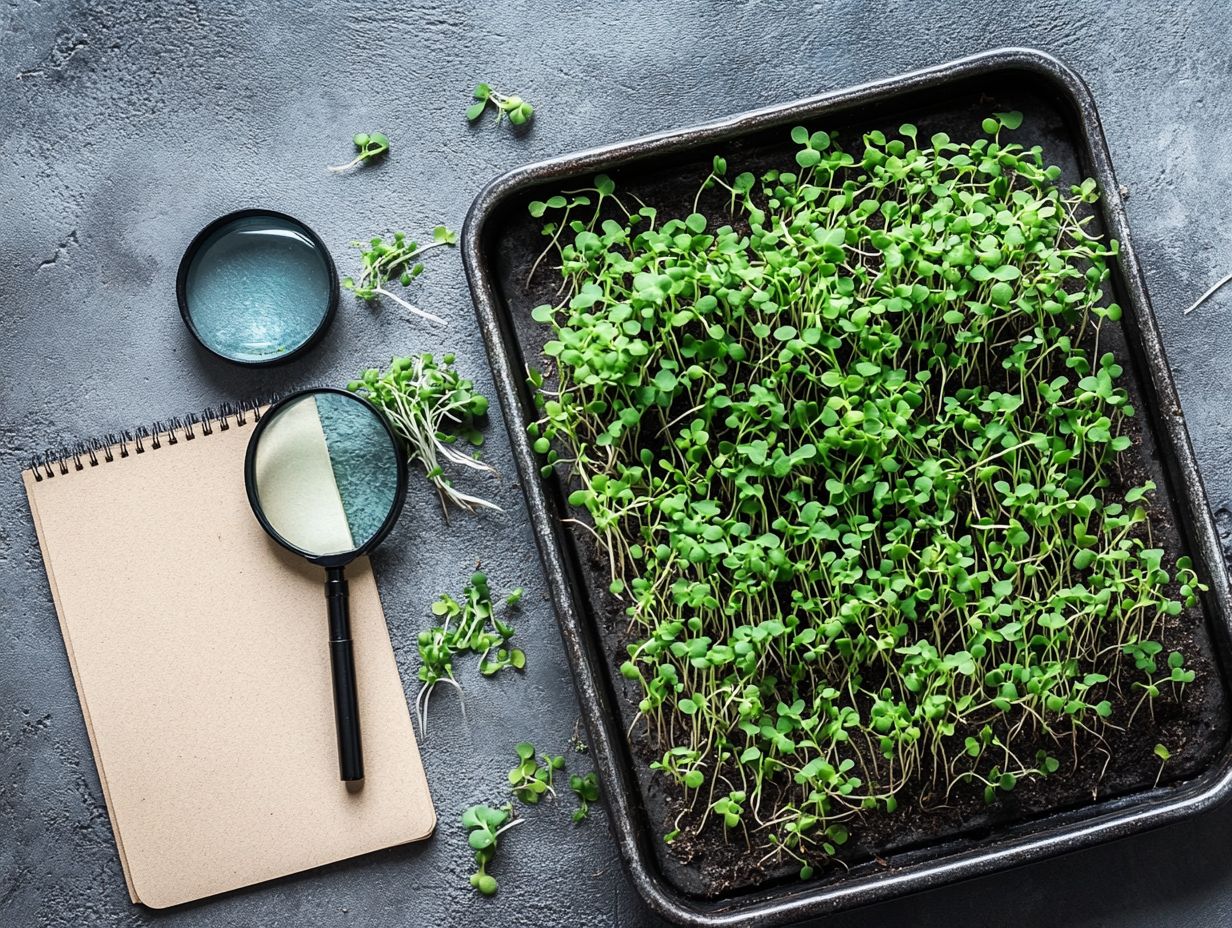
Insufficient light exposure can result in leggy growth for your microgreens, rendering them weak and lacking in nutrition. On the other hand, too much light can stress the plants, leading to leaf burn and stunted development.
It is vital to monitor both the duration and intensity of light. This helps microgreens thrive. They will reach their full nutritional potential.
To cultivate healthy microgreens effectively, aim for a bright yet indirect light source for about 12 to 16 hours each day during the seedling stage. As they mature, slightly reducing this duration can be beneficial, allowing for around 10 to 12 hours of light.
If you notice yellowing leaves or excessive stretching toward the light, it’s a clear sign of deficiency. You can rectify this by increasing exposure time or intensity. If the leaves become crispy or develop dark spots, it may indicate overexposure. In that case, you should reduce the light duration or relocate them to a less intense light setup. For more information on this topic, refer to our guide on understanding light needs for microgreens.
Watering Issues
Watering issues pose a significant challenge for people growing microgreens. Both overwatering and underwatering can impede growth and lead to nutrient deficiencies in your seedlings.
By implementing proper watering practices and ensuring effective drainage, you can maintain optimal moisture levels. This helps microgreens thrive and fully realize their nutritional potential.
Over or Under Watering
Over or under-watering can wreak havoc on your microgreens, leading to sluggish growth and a higher likelihood of mold. Recognizing the signs of overwatering like wilting or yellowing leaves and under-watering, which manifests as dry soil and stunted growth, will help you refine your watering techniques and ensure proper drainage.
To achieve optimal growth, it s crucial to monitor moisture levels consistently. A straightforward method is to stick your finger about an inch into the soil; if it feels dry, it s time to water, while moist soil indicates you might be overwatering.
Using a moisture meter can offer more accurate readings to refine your watering schedule. Remember, adjustments may be necessary depending on the specific types of microgreens you re cultivating, as some varieties have unique moisture needs.
By keenly observing your plants, you can promptly tackle any water-related issues and nurture healthy, thriving microgreens while avoiding common problems like mold.
Pest Infestations
Pest infestations can jeopardize the health of your precious microgreens. Watch out! Aphids can quickly damage your microgreens if not dealt with immediately.
However, by employing preventive strategies such as using neem oil, you can effectively shield your microgreens from these potential threats.
Preventing and Treating Common Pests
Preventing and treating common pests in microgreens is essential for maintaining healthy plants and maximizing your yield. By regularly inspecting for visible pests and strategically using neem oil alongside other organic solutions, you can effectively deter infestations and promote a thriving microgreen garden.
Establish a routine that includes checking the undersides of leaves and the soil for any signs of unwanted guests. Integrating pest management strategies will not only help you identify potential issues early but also ensure your garden remains resilient against various threats.
Neem oil, renowned for its effectiveness as a natural pesticide, can be diluted and applied as a preventive spray, creating an unwelcoming environment for pests while protecting beneficial insects. When you pair this with proper sanitation and good airflow, you significantly reduce the likelihood of infestations, allowing your microgreens to truly flourish.
Nutrient Deficiencies
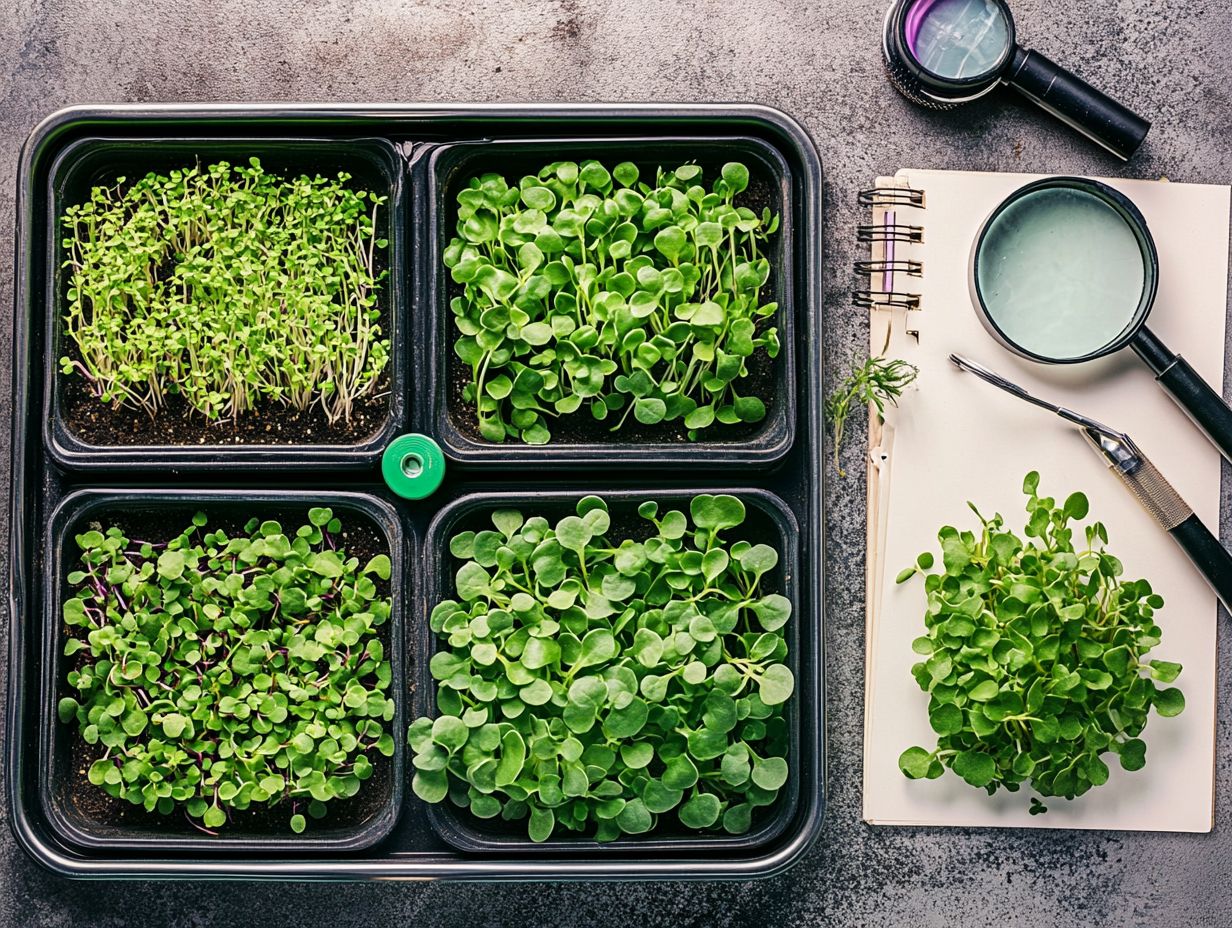
Nutrient deficiencies can significantly impact the growth and vitality of microgreens. Understanding and addressing these challenges is vital for their overall health.
Utilizing organic fertilizer, such as compost or seed starting mix, along with good watering practices, can greatly enhance soil health. This approach delivers the essential nutrients needed for optimal plant growth.
Identifying and Correcting Nutrient Deficiencies
Identifying and correcting nutrient deficiencies in your microgreens is essential for achieving healthy growth and impressive yields. If you notice symptoms like slow growth or discoloration, it s a clear signal that essential nutrients may be lacking.
Assessing soil quality and considering the application of organic fertilizers is crucial for replenishing those nutrient levels. Watch out for common signs: yellowing leaves might suggest a nitrogen deficiency. Purple veins could indicate a phosphorus shortage, while a lack of magnesium often results in yellowing between the veins.
Correcting these deficiencies requires a keen examination of your growing medium and the implementation of targeted soil amendments. Incorporating compost or organic fertilizers can effectively tackle these issues, promoting healthier plants overall.
Regular soil testing helps you keep track of nutrient levels. This allows you to fine-tune your fertilization practices based on real-time data and the specific needs of your plants.
Harvesting and Storage Tips
Harvesting and storing microgreens carefully ensures you enjoy their amazing flavor and health benefits. By adopting best practices during the harvesting process and using effective storage techniques, you can significantly extend the shelf life of your microgreens.
Best Practices for Harvesting and Storing Microgreens
Adhering to best practices for harvesting and storing microgreens is essential for preserving their flavor and nutritional value. Timing your harvest just before the first true leaves emerge can significantly enhance their taste.
Use proper storage techniques like well-draining containers to help keep them fresh for a longer period. To truly elevate the quality of these delicate greens, consider harvesting them in the early morning when they are at their most hydrated.
Using sharp scissors allows you to make a clean cut, minimizing damage to the remaining plants. Once harvested, transfer the microgreens into ventilated containers to maintain optimal humidity levels, vital for preventing spoilage. Additionally, familiarizing yourself with understanding microgreen growth phases can help enhance your harvesting techniques.
Store them in the refrigerator at a slightly elevated humidity to extend their shelf life. Placing a damp paper towel inside the container helps retain moisture while preventing sogginess. This ensures that their vibrant flavors and nutrient density remain intact for as long as possible.
Frequently Asked Questions
What are common microgreen growth issues and how can I troubleshoot them?
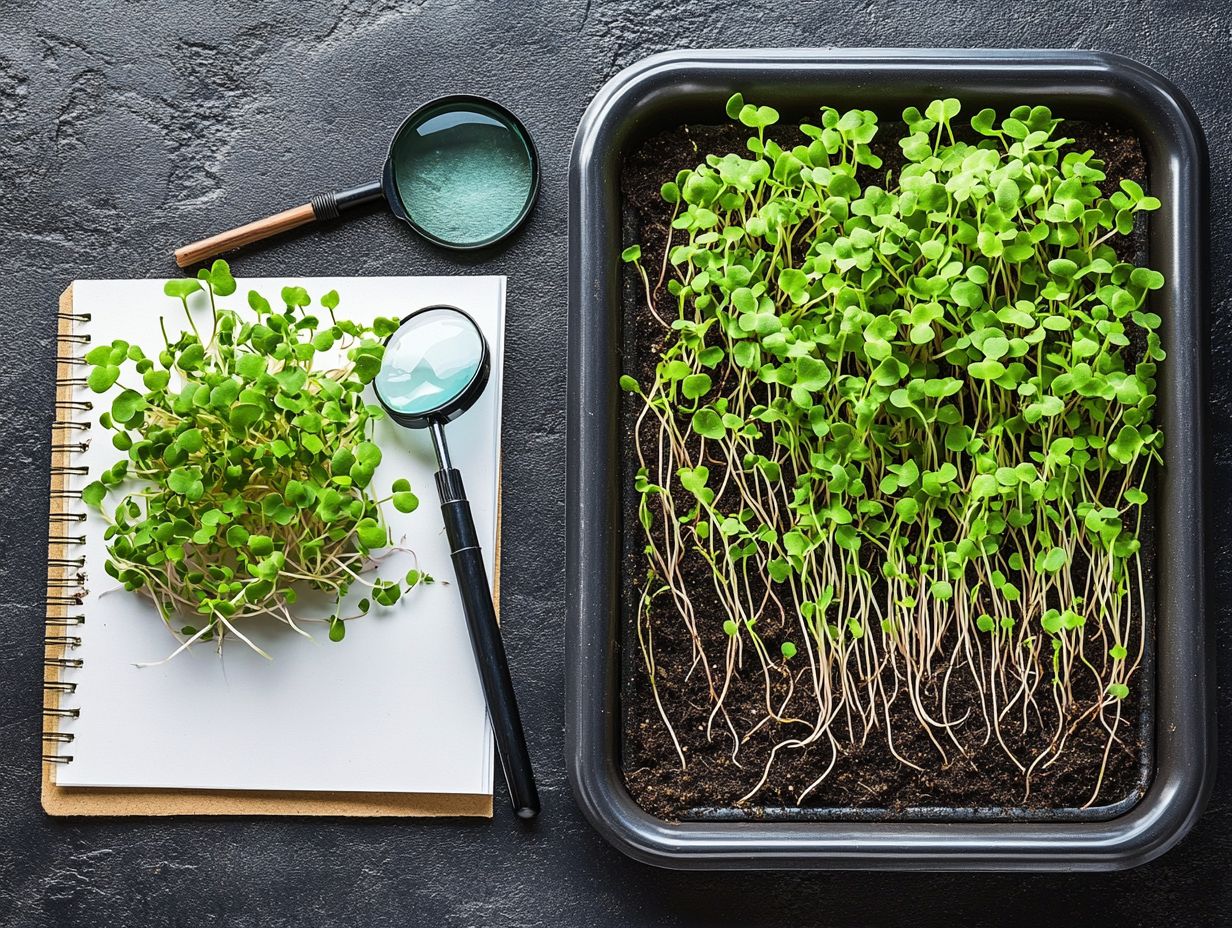
Common microgreen growth issues include poor germination, stunted growth, yellowing leaves, and mold. To troubleshoot these problems, make sure you are using high-quality seeds, providing enough light and water, and maintaining proper air circulation and temperature.
Regularly inspect your microgreens for any signs of pests or diseases.
Why are my microgreens growing slowly and not reaching their full size?
Slow growth and miniature size can be caused by insufficient light, improper watering, or overcrowding. Ensure your microgreens are receiving at least 12 hours of light per day.
Water adequately but not excessively, and space them out evenly to allow for proper airflow and nutrient absorption.
My microgreens are turning yellow. What could be the cause?
Yellow leaves often mean overwatering, nutrient shortage, or disease. Check your watering schedule to avoid giving too much water.
Fertilize with a balanced organic fertilizer and watch closely for pests or diseases.
I noticed mold growing on my microgreens. What should I do?
Mold spreads quickly and can damage your microgreens. Act fast by removing affected plants and surrounding soil.
Boost air circulation with a small fan and avoid overwatering. Sterilize your containers and use fresh soil for each batch to keep mold at bay.
How can I prevent pests from damaging my microgreens?
Pests like aphids and mites can harm your microgreens. Regularly check your plants for signs of pests and isolate any affected ones.
Use natural insecticides like neem oil and consider companion planting with herbs like basil and mint to deter pests.
What are some best practices to ensure successful microgreen growth?
For successful growth, use high-quality organic seeds and ensure your microgreens get enough light, water, and air circulation.
Maintain proper temperature and humidity, stick to a consistent watering and fertilizing schedule, and clean your containers and tools between batches.

